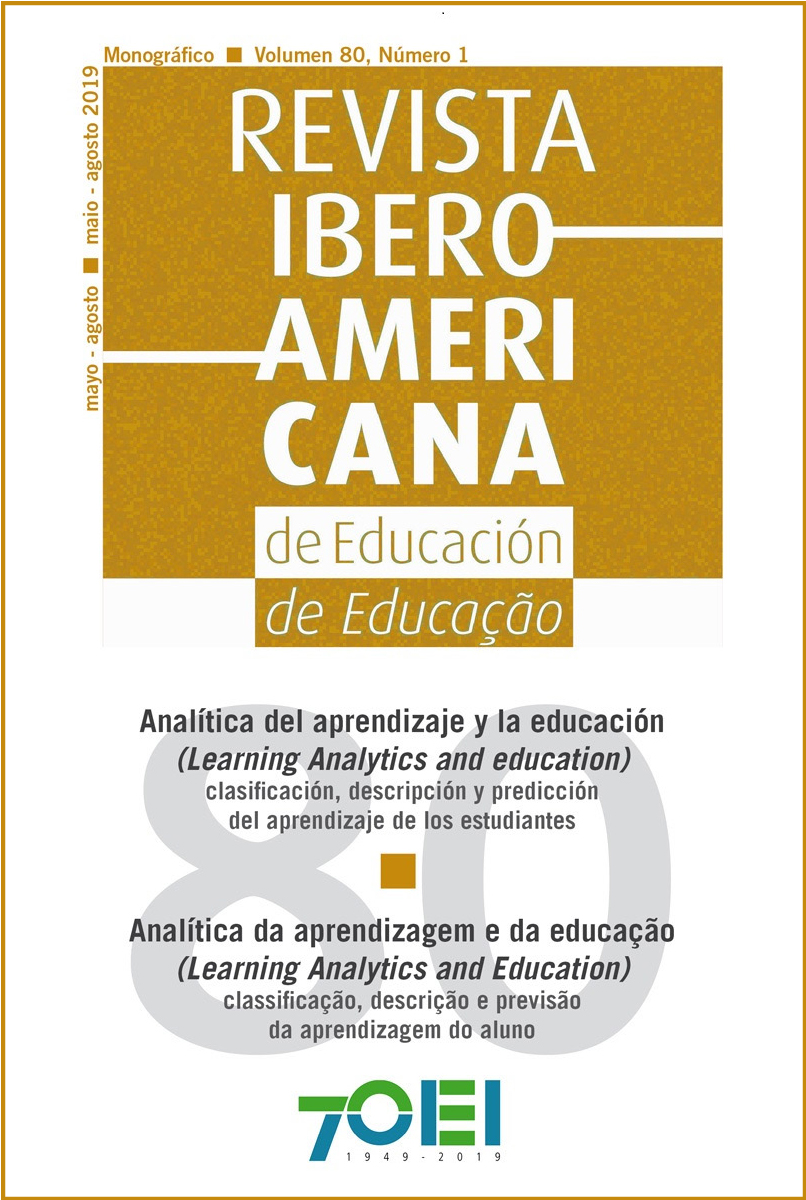Indicators needed to design a student dashboard from teachers’ perspectives: a qualitative study
DOI:
https://doi.org/10.35362/rie8013462Keywords:
learning analytics; dashboard; course design; teacher; student learning process; self-regulationAbstract
The number of students’ enrolled in Higher Education online courses is increasing, and as a result, more data about their learning process is generated. The data produced can be displayed on a dashboard and help students in their learning process. However, teachers’ perspective should be taken into account to define the indicators of the dashboard as the design of the courses could impact on the elements included on it. And that is precisely the aim of this paper: to define the indicators needed to design a student dashboard in online courses taking into account teachers' perspectives. This study was carried out with 10 teachers from the Faculty of Humanities and Education from Mondragon Unibertsitatea. Online qualitative questionnaires were used to gather participants’ perceptions. Results show that most of the teachers participating in the research study identified four indicators to design a student dashboard: number of times students access the course forum, amount of contributions in the forum, number of times students consult the information booklet, and number of times each student has accessed the course in a week time. Conclusions drawn from this study highlight the importance of training teachers and students on the pedagogical use of data visualization.
Downloads
References
Baker, B. M. (2007). A conceptual framework for making knowledge actionable through capital formation. University of Maryland University College.
Buckingham Shum, S., & Ferguson, R. (2012). Social learning analytics. Educational Technology & Society, 15(3), 3-26.
Corrin, L., & de Barba, P. (2015). How do students interpret feedback delivered via dashboard? Paper presented at the International Conference on Learning Analytics and Knowledge, Poughkeepsie, NY.
Dawson, S., Gasevic, D., Siemens, G., & Joksimovic, S. (2014). Current state and future trends: a citation network analysis of the learning analytics field. Paper presented at the International Conference on Learning Analytics and Knowledge, Indianapolis, IN.
Dawson, S., Bakharia, A., & Heathcote, E. (2010). SNAPP: Realising the affordances of real-time SNA within networked learning environments. Networked Learning-Seventh International Conference.
Dawson, S., Heathcote, E., & Poole, G. (2010). Harnessing ICT potential: The adoption and analysis of ICT systems for enhancing the student learning experience. International Journal of Educational Management, 24(2), 116-128.
Ferguson, R. (2012). The state of learning analytics in 2012: a review and future challenges (KMI-12-01). The Open University, UK.
Few, S. (2007). Dashboard confusion revisited. Perceptual Edge.
Gasevic, D., Dawson, S., & Siemens, G. (2015). Let´s not forget: learning analytics are about learning. TechTrends, 59, 64-75.
Goodyear, P. (2015). Teaching as design. HERDSA Review of Higher Education Vol. 2, (pp. 27-50).
Heathcote, E. (2006). Learning design templates-A pedagogical just-in-time support tool. In G. Minshull & J. Mole (Eds.), Designing for learning: The proceedings of Theme 1 of the JISC Online Conference: Innovating e-Learning (pp. 19-26).
Ipiña, N., Basagoiti, R., Jimenez, O., & Arriaran, I. (2016). Recommendations as a key aspect for online learning personalization: perceptions of teachers and students. International Scholarly and Scientific Research & Innovation 10(10) 3391-3395. doi:10.5281/zenodo.1127511
Krumm, A. E., Waddington, R. J., Teasley, S. D., & Lonn, S. (2014). A learning management system-based early warning system for academic advising in undergraduate engineering. In J. A. Larusson & B. White (Eds.), Learning analytics: from research to practice (pp. 103-119). New York: Springer Science+Business Media.
Leony, D., Pardo, A., de la Fuente Valentín, L., De Castro, D. S., & Kloos, C. D. (2012). GLASS: A learning analytics visualization tool. 2nd International Conference on Learning Analytics and Knowledge.
Lockyer, L., Heathcote, E., & Dawson, S. (2013). Informing pedagogical action: Aligning learning analytics with learning design. American Behavioral Scientist 57 (10) 1439-1459.
Means, B. (2014). Learning Online. What research tells us about whether, when and how. New York: Routledge.
Mor, Y., Ferguson, R., & Wasson, B. (2015). Editorial: Learning design, teacher inquiry into student learning and learning analytics: A Call for action. British Journal of Educational Technology, 46(2), 221-229.
Pardo, A., Jovanovic, J., Dawson, S., Gasevic, D., & Mirriahi, N. (2017). Using learning analytics to scale the provision of personalised feedback. British Journal of Educational Technology. doi: 10.1111/bjet.12592.
Rientes, B., Boroowa, A., Cross, S., Kubiak, C., Mayles, K., & Murphy, S. (2016). Analytics4Action evaluation framework: A review of evidence-based learning analytics interventions at the Open University UK. Journal of Interactive Media in Education, 1(2), 1-11. doi:10.5334/jime.394
Schwendimann, A., Rodriguez-Triana, M. J., Vozniuk, A., Prieto, L. P., Shirvani Boroujeni, M., Holzer, A., Gillet, D., Dillenbourg, P. (2016). Perceiving learning at a glance: A systematic literature review of learning dashboard research. IEEE Transactions on Learning Technologies 10(1), 1-1. doi:10.1109/TLT.2016.2599522
Steiner, C. M., Kickmeier-Rust, M. D., & Albert, D. (2014). Learning analytics and educational data mining: An overview of recent techniques. Learning analytics for and in serious games, pp. 6-15.
Sutherland, R., Eagle, S., & Jobert, M. (2012). A vision and strategy for Technology Enhanced Learning. STELLAR Network of Excellence.
Tanes, Z., Arnold, K. E., King, A. S., & Remnet, M. A. (2011). Using signals for appropiate feedback: perceptions and practices. Computers & Education, 57, 2414-2422. doi:10.1016/j.compedu.2011.05.016
Verbert, K., Govaerts, S., Duval, E., Santos, J.L., Assche, F., Parra, G., et al. (2014). Learning dashboards: an overview and future research opportunities. Personal and Ubiquitous Computing, 18 1499-1514. doi:10.1007/s00779-013-0751-2
Wise, A. F. (2014). Designing pedagogical interventions to support student use of learning analytics. Paper presented at the International Conference on Learning Analytics and Knowledge, New York, NY.
Yoo, Y., Lee, H., Jo, I. H., & Park, Y. (2015). Educational dashboards for smart learning: Review of case studies. Emerging Issues in Smart Learning. Springer, (pp. 145-155).
How to Cite
Downloads
Published
Issue
Section
License
Any authors who publish with this journal accept the following terms:















